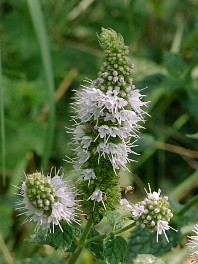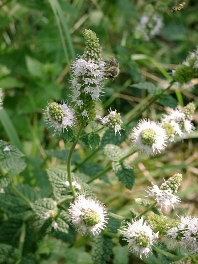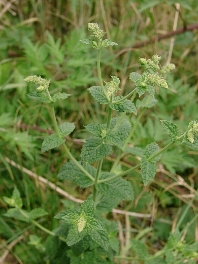 Nearly everybody knows the Peppermint from refreshing herb teas,
that are drunken even if one is healthy.
Nearly everybody knows the Peppermint from refreshing herb teas,
that are drunken even if one is healthy.
But the Peppermint is a strong herbal remedy as well.
It strengthen the digestion and can allay nervous pains.
The Peppermint is easy to grow in gardens and as it is perennial it grows again year by year.
Other kinds of mint work similar to the peppermint.
Medicinal Uses
- Antibacterial
- Antiseptic
- germicidal
- Calming
- Inflammation-adverse
- Gall stimulating
- Spasm-dissolvent
- Analgesic
- Strengthening
- Loss of appetite
- Flatulences
- Diarrhea
- Gall complaints
- Stomachache
- Stomach convulsions
- Nausea
- Digestive weakness
- Mouth smell
- Kidney weakness
- Heart weakness
- Sleeplessness
- Headaches
- Migraine
- Nerve pain
- Sciatica
- Lumbago
- Rheumatism
- Painful menses
- Menopause complaints
- Flu
- Bad healing wounds
Information
| Used Parts: | Leaves |
| Substances: | Essential oil, Menthol, Menthone, Bitter essence, Flavonoid, Tannic essence, Tannic acid, Jasmone, Limonene, Menthofuran, Valerianic acid |
| Time to collect: | Early summer befor they blossom |
Methods

Internal as tea
You can drink the peppermint as a tea.It help against weakness of the digestive system.
Peppermint tea can help also against headache, because you inhale the essential oils of the mint while drinking the tea.
In arabic countries people drink a lot of mint tea, day by day.
External use
You can use the mint tea for washing or bathing against bad healing wounds or rheumatic and nervous pains.Poultices are also good for these uses.
A poultice on the forehead can allay headaches.
Essential oil - external
The inhalation of the essential oil helps against colds and makes breathing more easy.You can also apply the dilutes essential oil to the breast or the sides of the nose to assist breathing.
As the essential oil blocks the nerves in feeling pain, mint oil can help against pain.
Applied on the forehead and the temples it can soften migraine.
First the oil feels cold on the skin, later it becomes warm.
So you can use it against muscle pains and nervous pains like sciatica or lumbago. It can also help against rheumatic pain.
View:
Beware!
Never put mint oil to the eyes because this would sting in the eyes.
Essential oil - internal
If you have a good mint oil you can use it internally but only diluted and with care, because it is very strong.Internally taken the mint oil can help the gall bladder to work stronger.
It also releases spasms.
|
Beware!
Never take Peppermint internally when you are pregnant. It could start birth to early.
Also: |
Plant description
 The Peppermint is a bastard brother of the Spearmint,
that came to existence in the 17th century in England.
Therefore the Peppermint is not wild plant but has its source in a garden.
The Peppermint is a bastard brother of the Spearmint,
that came to existence in the 17th century in England.
Therefore the Peppermint is not wild plant but has its source in a garden.
The Peppermint spreads mainly by its growing roots, that build more and more plant, if it likes the place.
The perennial plant becomes up to 50 cm high. It has a stalk the gets several branches in the top if it has enough place.
The leaves of the Peppermint are dark green and have toothed margins. If you rub the leaves between your fingers you can smell the typical Peppermint arome.
The flowers blossom from June on in whorls at the top of the stems. They are white to light purple.
